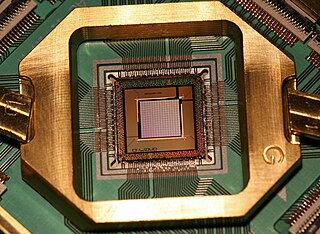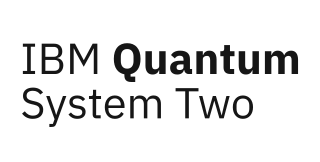Related Research Articles

A quantum computer is a computer that exploits quantum mechanical phenomena. On small scales, physical matter exhibits properties of both particles and waves, and quantum computing leverages this behavior using specialized hardware. Classical physics cannot explain the operation of these quantum devices, and a scalable quantum computer could perform some calculations exponentially faster than any modern "classical" computer. Theoretically a large-scale quantum computer could break some widely used encryption schemes and aid physicists in performing physical simulations; however, the current state of the art is largely experimental and impractical, with several obstacles to useful applications.

This is a timeline of quantum computing.
Superconducting quantum computing is a branch of solid state physics and quantum computing that implements superconducting electronic circuits using superconducting qubits as artificial atoms, or quantum dots. For superconducting qubits, the two logic states are the ground state and the excited state, denoted respectively. Research in superconducting quantum computing is conducted by companies such as Google, IBM, IMEC, BBN Technologies, Rigetti, and Intel. Many recently developed QPUs use superconducting architecture.

D-Wave Quantum Systems Inc. is a quantum computing company with locations in Palo Alto, California and Burnaby, British Columbia. D-Wave claims to be the world's first company to sell computers that exploit quantum effects in their operation. D-Wave's early customers include Lockheed Martin, the University of Southern California, Google/NASA, and Los Alamos National Laboratory.
D-Wave Two is the second commercially available quantum computer, and the successor to the first commercially available quantum computer, D-Wave One. Both computers were developed by Canadian company D-Wave Systems. The computers are not general purpose, but rather are designed for quantum annealing. Specifically, the computers are designed to use quantum annealing to solve a single type of problem known as quadratic unconstrained binary optimization. As of 2015, it was still debated whether large-scale entanglement takes place in D-Wave Two, and whether current or future generations of D-Wave computers will have any advantage over classical computers.
IBM Quantum Platform is an online platform allowing public and premium access to cloud-based quantum computing services provided by IBM. This includes access to a set of IBM's prototype quantum processors, a set of tutorials on quantum computation, and access to an interactive textbook. As of February 2021, there are over 20 devices on the service, six of which are freely available for the public. This service can be used to run algorithms and experiments, and explore tutorials and simulations around what might be possible with quantum computing.
Cloud-based quantum computing is the invocation of quantum emulators, simulators or processors through the cloud. Increasingly, cloud services are being looked on as the method for providing access to quantum processing. Quantum computers achieve their massive computing power by initiating quantum physics into processing power and when users are allowed access to these quantum-powered computers through the internet it is known as quantum computing within the cloud.

Rigetti Computing, Inc. is a Berkeley, California-based developer of quantum integrated circuits used for quantum computers. The company also develops a cloud platform called Forest that enables programmers to write quantum algorithms.
In quantum computing, a qubit is a unit of information analogous to a bit in classical computing, but it is affected by quantum mechanical properties such as superposition and entanglement which allow qubits to be in some ways more powerful than classical bits for some tasks. Qubits are used in quantum circuits and quantum algorithms composed of quantum logic gates to solve computational problems, where they are used for input/output and intermediate computations.
Quantum volume is a metric that measures the capabilities and error rates of a quantum computer. It expresses the maximum size of square quantum circuits that can be implemented successfully by the computer. The form of the circuits is independent from the quantum computer architecture, but compiler can transform and optimize it to take advantage of the computer's features. Thus, quantum volumes for different architectures can be compared.

Qiskit is an open-source software development kit (SDK) for working with quantum computers at the level of circuits, pulses, and algorithms. It provides tools for creating and manipulating quantum programs and running them on prototype quantum devices on IBM Quantum Platform or on simulators on a local computer. It follows the circuit model for universal quantum computation, and can be used for any quantum hardware that follows this model.

IBM Quantum System One is the first circuit-based commercial quantum computer, introduced by IBM in January 2019.

Sycamore is a transmon superconducting quantum processor created by Google's Artificial Intelligence division. It has 53 qubits.
The current state of quantum computing is referred to as the noisy intermediate-scale quantum (NISQ) era, characterized by quantum processors containing up to 1,000 qubits which are not advanced enough yet for fault-tolerance or large enough to achieve quantum advantage. These processors, which are sensitive to their environment (noisy) and prone to quantum decoherence, are not yet capable of continuous quantum error correction. This intermediate-scale is defined by the quantum volume, which is based on the moderate number of qubits and gate fidelity. The term NISQ was coined by John Preskill in 2018.
IBM Eagle is a 127-qubit quantum processor. IBM claims that it can not be simulated by any classical computer. It is two times bigger than China's Jiuzhang 2. It was revealed on November 16, 2021 and was claimed to be the most powerful quantum processor ever made until November 2022, when the IBM Osprey overtook it with 433 qubits. It is almost twice as powerful as their last processor, the 'Hummingbird', which had 65 quantum bits and was created in 2020. IBM believes that the processes used in creating the 'Eagle', will be the backbone for their future processors.

IBM Quantum System Two is the first modular utility-scaled quantum computer system, unveiled by IBM on December 4, 2023.
IBM Osprey is a 433-qubit quantum processor created by IBM, revealed during the IBM Quantum Summit 2022, which occurred on November 9, 2022, in New York, United States.
IBM Condor is a 1,121-qubit quantum processor created by IBM, unveiled during the IBM Quantum Summit 2023, which occurred on December 4, 2023. It is the 2nd largest quantum processor, just shy of the 1,125-qubit quantum processor by the company Atom, created in October 2023.
IBM Think is an annual business conference organized by IBM. Before 2018, IBM held similar business conferences under different names. Think is seen as a successor to World of Watson that was held in 2017. The conference name is a reference the 'Think' slogan used by IBM.
References
- 1 2 3 4 "IBM Debuts Next-Generation Quantum Processor & IBM Quantum System Two, Extends Roadmap to Advance Era of Quantum Utility". IBM Newsroom. Retrieved 2023-12-25.
- 1 2 3 "IBM unveils Heron quantum processor and new modular quantum computer". Network World. Retrieved 2023-12-27.
- ↑ "IBM Quantum delivers on 2022 100x100 performance challenge | IBM Quantum Computing Blog". www.ibm.com. Retrieved 2024-11-15.